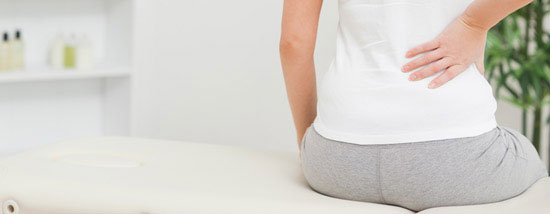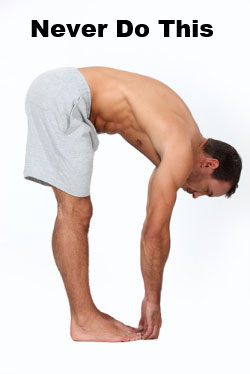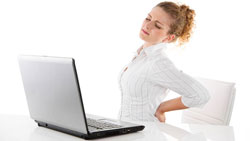5 Very Easy Tips for Chronic Lower Back Pain
By Sherwin Nicholson | May 4, 2020

If managing your pain has become hard, start with these 5 easy tips. They will change your approach dramatically.
1. Never Touch Your Toes (to stretch)
Never means never.
 This is a terrible way to test for flexibility or for back issues. If anyone suggests this method, be wary of their advice.
This is a terrible way to test for flexibility or for back issues. If anyone suggests this method, be wary of their advice.
Why? Leaning forward to touch your toes generates the most torque and force on the lumbar discs. This is dangerous.
By doing this you will risk injury and spasms. This movement does nothing to test for flexibility. The more that you bend or lean to stretch your hamstrings, the higher the pressure to your discs becomes.
You can easily stretch these muscles without causing harm to your discs. People who are not serious about how to properly stretch their hamstrings, will perform this action. They may be successful for some time but their discs will fail at some point.
At the other end of the spectrum, people who are fully able to stretch their hamstrings can perform this movement without risk of injury. This makes the test pointless to them as they do not need it in the first place.
If you were to design a way to deliberately harm your L5-S1 disc (the most important and vulnerable), it would include any method of leaning forward with your full upper body weight and holding. Hence touching your toes. Avoid this test at all costs.
Leaning forward to touch your toes generates the most torque and force on the lumbar discs. This is dangerous.
2. Engage Your Legs and Hips More than Your Upper Body
We all fail to use our lower body as much as our upper when required.
In fact, this is where the problem lies. If you use your leg muscles more to bend, pick up, reach or lower yourself, you will use your back less.
Before you consider leaning forward (which requires pressure on the lumbar spine), use your legs instead to bend to lower. This should be a conscious effort each time. It will not feel comfortable at first but it will benefit your health.
3. Do Not Rely on Your Lumbar Support when Sitting
Even the most ergonomic chairs provide minimal support. That is when compared with the support that your spine muscles, hips and posture should be providing instead.
A backrest is a rest and not a support. If you let your muscles relax while upright, then there is NO support contributed from the body. This means that your ergonomic chair is not helping your back. It only improves your comfort. You may feel better, but your chronic pain is still there.
The best way to sit is unassisted, upright, knees shoulder width apart, elbows close to the body, head up and with your eyes looking forward or slightly down. Maintain a slight arch in your spine with your chest slightly pushed out. 
You can lower one thigh and knee down to the side for additional support. You can also use your arms to rest on your table or desk in front of you.
Use the backrest as little as possible. Only use it primarily to help tilt your pelvis forward toward neutral position. Sitting causes your pelvis to tilt backwards which can hurt you.
You will find this new position difficult to maintain and somewhat tiring. It does not mean that you should not continue it. It is a sign that your body is relying on rest instead of activity for support.
Over time, your back muscles will be able to sit upright unassisted with very little energy expended. You will feel much less sore when you sit and later when you stand. You will be able to sit anywhere and feel comfortable.
4. Exercise Your Supportive Muscles
If you do not exercise now or do not like to, then you will not be able to correct your chronic issues. No health care professional has even recommended an exercise free treatment exclusively.
The types of exercises that you should be performing are not the kind that you would imagine having to suffer through in the hope that they may help.
You are not trying to incorporate stressful, sport-like, cardio-class, extreme yoga workouts. That is not what you need. You need simple, safe and easy exercises that function to correct your daily movements and muscle imbalances. These type of exercises serve to correct what you have not been performing well initially.
5. Use Medications Wisely
It is between you and your health care professional how to use your medication. If you are using them as a supplement to pop whenever it deems suitable, then you are abusing both the drug and your body. 
Taking medication to avoid pain may be necessary when you need it to function for important areas in your life. Taking them as to avoid other more effective treatments is not.
Don’t dull your senses whenever its hurts. Use it as a sign that something more significant should be done. Sometimes we associate emotional pain with physical pain too often.
We find that by taking medication to avoid pain, we can help the emotional toll that comes with it. If you have been affected to the point of giving up on most treatments and relying on medication solely, seek help.
Here are some reasons we struggle:
- too busy, not enough spare time
- other priorities
- the pain is only mild or temporary
- my management is sufficient
- fear of worsening the injury
- aversion to exercise
- doubt of exercise
- willingness to accept chronic pain
- reliance on medication
There are of course more reasons that can be listed.
Some of the above are valid, but many are used to avoid or delay proper care and treatment. Doing this increases your risk of further injury.
To help break the cycle of what is only pain management and to reduce further possible critical:
Be Proactive Now
Do not wait until there is a severe episode to take action.
Most people assume that their back are fine. Whether or not this is true, this gives some an excuse to neglect their spine.
We assume that if there is no pain, then there are no issues. Does not having pain imply that you are 100% healthy and safe? Your spine is usually prone to some injury whether mild or severe. Back problems are not only sudden but cumulative. A simple bad habit such as poor posture, poor lifting or risky exercises over time can lead to more serious issues.
Bonus tips that help:
Here is a much better hamstring stretch
References:
- Management of chronic lbp – Nikolai Bogduk Med J Aust 2004; 180 (2): 79-83. https://www.mja.com.au/journal/2004/180/2/management-chronic-lbp
- Self-management education en masse: effectiveness BP: Don’t Take It Lying Down mass media campaign – Rachelle Buchbinder Med J Aust 2008; 189 (10 Suppl): S29. https://www.mja.com.au/journal
- Effects of Stabilization Exercises on Health-Related Quality of Life in Women With Chronic lbp. – Moussouli M(1), Vlachopoulos SP, Kofotolis ND, Theodorakis Y, Malliou P, Kellis
